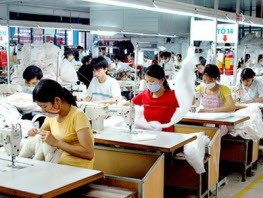Vietnam’s garments and textile sector targets 15 billion USD in exports
(VOVworld) Last year, Vietnam earned 14 billion USD from garment and textile exports, one-year increase of 30%. This year, despite the global economic recession, the sector has maintained its position as Vietnam’s export leader.
 |
| Garments and textile sector targets 15 billion USD of export turnover in 2012 |
Despite a slumping world economy, Vietnam’s apparel sector remains one of the country’s top 5 hard currency earners. The Vietnam Textile and Apparel Association says that in 2010 the industry’s export revenues totaled 11.2 billion dollars, in 2011, more than 13.5 billion dollars, and this year could reach 15 billion dollars. Many companies already have signed contracts through the end of the first quarter. Some even have orders through the end of the year, thanks to good market forecasting and the cultivation of trust with trading partners. Nguyen Thi Thanh Huyen, Director General of the Garment Joint Stock Company No 10 says ‘
Our company has maintained growth in three major markets - the US, the EU, and Japan. And we continue to be strongly competitive with other domestic companies’.
To maintain the growth rate, the sector has adopted various strategies focusing on developing the domestic market while gradually restructuring the whole sector on top of market expansion. Le Tien Truong, Vice President of the Vietnam National Garment and Textile Group explains ‘Last year’s trade surplus recorded a remarkable increase to 6.5 billion USD, 1.8 billion higher than the previous year. I think in the long term, despite price fluctuations in the world market, the most important thing for the sector is turning the trade surplus into high profitability for the country’.
 |
Vietnam earned 14 billion USD from garments and textile exports last year
|
Many enterprises have worked hard to tap new markets such as the Republic of Korea, Angola, New Zealand and India. The first batch of polyester fiber has rolled out from the Đình Vũ polyester fiber plant in Hai Phong. The plant will meet 40% of the domestic textile sector’s demand, and help reduce the import of polyester fiber. At the same time, the industry will improve the value of every FOB order, reduce its dependency on offshore outsourcing contracts, and increase ODM orders.
To Tuan